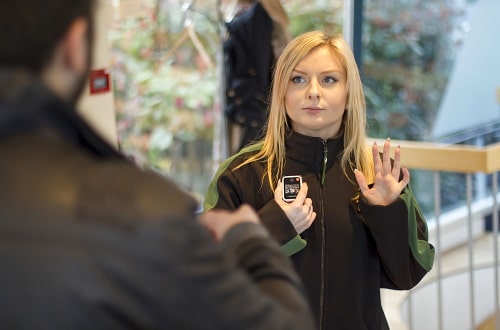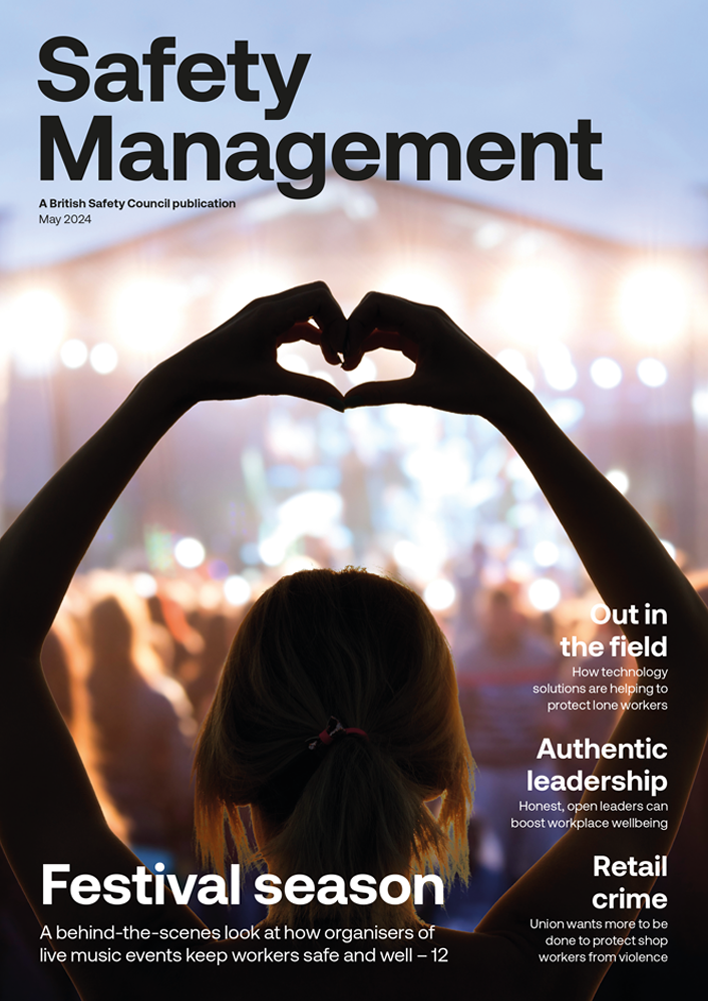As festivalgoers prepare to pull on their wellies, dig out their sunhats and dust off their tents ahead of another summer of live outdoor events, Safety Management looks behind the scenes at how festival organisers keep the armies of workers tasked with setting everything up safe and well.
Features
Backstage pass: how do festival organisers keep staff and visitors safe?
Festival sites have much in common with construction sites when it comes to physical hazards such as working at height, moving machinery and working outdoors. Or, as Tim Roberts, director of The Event Safety Shop (TESS), puts it: “People falling off things, people falling into holes, vehicles and plant machinery movement, and exposure to the elements outside”.
 Photograph: iStock/bernardbodo
Photograph: iStock/bernardbodo
In addition to managing these physical risks to workers, however, there is a growing emphasis on looking after the mental wellbeing of crews who are often working away from home for long periods of time in challenging conditions and with rigid deadlines to meet.
“People working within music and live events can be particularly at risk of mental health and addiction problems due to the uncertain nature of the industry; it is one of extreme highs and lows, whether you are an A-list artist or a member of the crew,” says Lynne Maltman, senior marketing and events specialist at Music Support, a charity that helps workers in the UK’s music and live events industry who are affected by mental ill health and/or addiction.
Music Support was founded in 2016 by people from within the music industry. It operates ‘Safe Hubs’ backstage at festivals, where artists and crew can take time out and speak to Mental Health First Aid trained staff. The charity also runs a confidential Helpline, and recently launched a Family and Friends service, to help those who are supporting someone who works in the music industry and is struggling with mental health issues or addiction problems.
 Music Support runs 'Safe Hubs' backstage at festivals for artists and crew. Photograph: Music Support
Music Support runs 'Safe Hubs' backstage at festivals for artists and crew. Photograph: Music Support
“People often work within music and live events for their love of it, so can neglect to look after themselves properly. This could be anything from working long days, to losing sleep, making poor food choices and getting carried away with the ‘excesses’ of what is seen as a ‘rock and roll’ lifestyle, with vices such as alcohol and drugs,” adds Maltman. “Being highly addictive substances, their vices can often be used to medicate common stressors such as anxiety and depression, which can eventually lead to burnout.”
Big operations
For the larger outdoor music festivals, it takes an army of dedicated professionals to build what is essentially a temporary city in a field. Every June, apart from in fallow years, for instance, more than 900 acres of farmland in Somerset is transformed into a canvas city housing more than 200,000 revellers who flock to the site for the five-day-long Glastonbury Festival.
 It takes an army of dedicated professionals to build what is essentially a temporary city in a field. Photograph: iStock/noonard
It takes an army of dedicated professionals to build what is essentially a temporary city in a field. Photograph: iStock/noonard
In advance of this, dozens of stages need to be built and wired up, temporary water supplies have to be plumbed in, and traffic management systems must be designed and implemented, to name just a few of the behind-the-scenes projects that help make everything tick.
“For all of those big infrastructure elements and the building of big stages and fencing – the heavy lifting that turns a greenfield environment into a temporary city where nobody gets an early night – those are professional people who are working away from home,” says Roberts, who set up The Event Safety Shop in 2000 after working for 12 years as the safety co-ordinator at Glastonbury Festival.
Those workers need to be housed, fed and kept safe during their time onsite.
“We build small villages to support the workers who are then building the bigger cities. Site cabins are brought in, and they’re already made up with beds, toilets and showers in them,” says TESS co-director Simon James, adding that some site crew at bigger festivals spend two to three months onsite setting everything up and taking it down.
“The majority of our workforces will be living onsite and they require food, so there are catering tents turning out 5-10,000 meals a day,” says James. “We have to look after them because they’re an incredibly important part of what goes on.”
It’s all in the planning
According to Chris Hannam, owner of Stagesafe – a health and safety consultancy that provides services to the live music events industry – setting up and running a safe festival comes down to careful forward planning and a detailed risk assessment.
“Event organisers and promoters should engage a fully qualified safety advisor as early on as possible in their planning,” says Hannam. “Waiting until much later, to save money, means mistakes and errors are made in the safety plan that can be almost impossible to rectify later. It’s all in the planning.”
The health and safety aspect of music festivals has come a long way since the early days, as Hannam recalls: “The whole idea of the industry at that time was that health and safety would place restraints on what they did – especially things like working at height. Nobody used a harness or a helmet – it just didn’t exist. If you wanted something done at height, you got somebody to do it. That’s just the way it was.”
Roberts agrees that the rock and roll nature of the music festival business meant that health and safety was not always the primary focus in the earlier days.
“I think it would be fair to say that the world of work, as carried out by people in factories and warehouses, didn’t really apply to the rock and roll business – that we were, somehow, not outside the law or beyond the reach of the law, but that it was for different sorts of activities,” he says. “There was definitely a strong desire to stay alive and in one piece, but technical and legal compliance was not at the forefront.”
Fast-forward to the early 1990s when the events industry’s health and safety ‘bible’ – the Purple Guide – was first published by the Health and Safety Executive (HSE), and things began to change. The document provides safety guidance to organisers of outdoor events. The Events Industry Forum took over publication of the Purple Guide in 2012 and it has since been revised and republished.
Another big change happened in 2015 when Construction (Design and Management) Regulations (CDM) were applied to the live events industry.
“CDM very much brought the attention of the industry because we all knew we built things and that’s a fundamental thing with most events,” says James. “It was a case of, ‘you’re not going to get out of this, so how are we going to make it work for you, and how can we ensure your workers are going to stay safe under these regulations?’”
CDM helped to clarify who the duty holders were “in a business where a huge proportion of people at that time were self-employed”, says Roberts.
The majority of people working on festivals in the UK, adds James, are freelancers or contracted companies, which adds an extra layer of complication. This means that “tens of thousands of briefings on safety, welfare and facilities” are typically handed out to individual workers before they arrive onsite.
Speaking at the SHW Live Manchester show earlier this year, Richard Bate – a vice-president of IOSH who has worked in the events industry for 40 years – stressed the importance of getting to know the relevant people from various contractors working on an event site.
“I have a questionnaire,” said Bates. “I might manage within an event space 20 or 30 contractors. I want to know who’s in charge; I want to know who has the key, who’s going to turn the lights off, who’s going to manage a crisis and, more importantly, who’s responsible for health and safety.
If I know that person, I’m going to sit down with them.”
Hit hard by Covid
The live events industry was hit particularly hard by the effects of the Covid-19 pandemic. As the world went into lockdown and gathering in crowds to watch live entertainment was out of the question, the industry was forced to grind to a halt. While this had a devastating impact on the livelihoods of people working in the sector, it gave pause for thought about how the industry could be improved when it did come back.
This thinking time, says James from TESS, led to an increased focus on the welfare and mental health of people working in the sector.
“I genuinely believe that in the last two years I’ve seen some really good welfare practice on provisions for crews working at festivals and shows,” he notes. “It’s being taken more seriously, rather than just, ‘put your hard hat on’, which was the refrain for years.”
 There has been an increased focus on the welfare and mental health of people working in the live events industry since the pandemic. Photograph: Music Support
There has been an increased focus on the welfare and mental health of people working in the live events industry since the pandemic. Photograph: Music Support
Eoghan O’Hagan, a family support manager at Music Support, agrees that there is more of a focus on wellbeing in the industry than in the past.
“The pandemic forced a significant percentage of the music and events industries to come to a complete standstill, giving many the time and space to refocus and reprioritise their wellbeing,” says O’Hagan. “The impact of the pandemic is still being felt; it is common for industry peers to seek help from Music Support for a decline in their mental health as a result. Many lost their careers, leading to experiencing grief for this loss.
“There is also a high correlation between sensitivity and creativity, meaning those in creative industries are more pre-disposed to experiencing mental ill health. Maintaining psychological wellbeing can be challenging in an industry that romanticises and normalises substance misuse.”
Martyn’s Law
Keeping the public safe is a key issue for events organisers. It was brought into sharp focus on 22 May 2017 when a suicide bomber detonated a homemade device in the foyer of Manchester Arena at the end of an Ariana Grande concert, killing 22 people and injuring hundreds of others. Following campaigning from the mother of one of the victims – Martyn Hett – legislation known as Martyn’s Law has been proposed and is undergoing consultation.
The proposed legislation aims to ensure that public premises are better prepared in the event of a terrorist attack. Under the proposed law, a standard tier would cover events with capacity for 100-799 people while an enhanced tier would apply to events with a capacity of more than 800.
Martyn’s Law is “a huge topic of discussion”, says Roberts from TESS, “but at the moment we are talking in a vacuum”. He adds: “We don’t know what the requirements are that are going to be placed on organisers; we don’t know who the regulator is going to be; we don’t know what duties or duty holders may be required within an organisation.”
Roberts anticipates that organisers of larger events “will be set a series of requirements that most of them are already meeting”, because they are aware that they could become terrorism targets.
“In the event business, we had to recognise that some people in this world consider enjoyment and entertainment a legitimate target for brutal assault,” he says, adding that “Manchester showed brutally that it’s not something that just happens on the other side of the world”.
Changing climate
Another big topic for festival organisers going forward is climate change. We are all used to seeing images from festivals showing conditions ranging from torrential downpours and mud baths, to baking hot sunshine. But as the weather becomes more extreme due to climate change, organisers of outdoor events may need to make changes to how and when they are held.
“Flooding and droughts are not only increasing in severity, they’re increasing in likelihood as well,” says Roberts. “We have to plan for that, and it’s difficult. To a degree, I think we may see a realignment of festival timings during the summer season, to go for more dependable months.”
However, he adds that there have been “some really strong developments” in the UK festival scene on reducing the carbon footprint of events, such as better use of renewables and greater awareness of the threat of climate change.
“The worsening climatic situation, hopefully, will be matched or exceeded by improvements in sustainability,” says Roberts.
FEATURES

Purchasing body-worn cameras: 10 top tips
By Alasdair Field, Reveal Media on 13 May 2024
Body-worn cameras can reduce the risk of violence and threats to staff by providing a deterrent effect and documentary evidence for pursuing aggressors, but it’s important to carefully consider issues like functionality, data storage and user training during the selection process.

Vulnerable workers: protection is key
By Naz Dossa, Peoplesafe on 13 May 2024
From working alone to commuting after hours, workers can be vulnerable to threats, aggression and harassment – but training and the right technology can help.

AI and worker wellbeing: a new risk for employers
By David Sharp, International Workplace on 10 May 2024
Data generated by machine learning and artificial intelligence at work looks set to play a huge role in boosting both worker health and safety and business productivity, but it’s vital that workers’ data used for algorithmic processing is handled lawfully, fairly and transparently.



